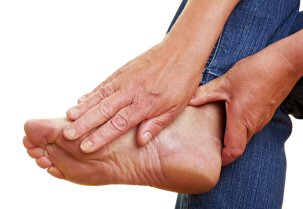Treating Plantar Fasciitis: Heel and Arch Pain
 A Common Foot Complaint A Common Foot Complaint
Foot woes and pains are typically caused by ill-fitting footwear, an improper
gait, or can be attributed to health problems such as diabetes. In the case of
heel and arch pain, the discomfort is often the result of a condition called
plantar fasciitis or PF.
Overpronation: The Usual Reason for the Pain
Plantar fasciitis is an inflammation of the plantar fascia. This part of the
foot is comprised of a connective tissue that runs from the base of the toes on
the backside of the foot to the heel bone. A common foot complaint, heel and
arch pain can occur for a number of reasons. Most people who suffer from PF
overpronate, or roll the foot inward when walking or running. Over time, the
stress put on the foot affects the nerves and tendons in the arch and heel.
Other Causes of PF
The condition can also be the result of wearing shoes that lack cushion or
support, being overweight, or running on uneven or downhill surfaces. An
Achilles tendon that is inelastic or too tight can cause PF as well. The
Achilles tendon, a fibrous tissue in the posterior leg, connects the heel band
in the foot to the muscles in the calf.
In fact, a tight Achilles tendon can cause quite a bit of foot discomfort as
it is also the strongest and most vulnerable ligament in the body. Used to
support such activities as standing on tip-toe, running, jumping, or walking,
the tendon can take a lot of pounding. So, if the Achilles tendon is tight or
not compliant, your heel and arch will undoubtedly start to complain.
Who is Affected by the Condition?
Although plantar fasciitis is regularly experienced by both women and men,
active men from 40 to 70 years of age seem to seek medical help more frequently
for the condition. In fact, whatís notable about plantar fasciitis is that it
occurs mainly in older people. You wonít usually see this condition occurring in
anyone younger than 25 years old.
Why Older People Often Are Affected by PF?
Thatís because the plantar fascia contains collagen, which tends to diminish
over time. As time passes, the fascia becomes less elastic, which can ultimately
lead to tears or injuries. In addition, obesity or reduced activity can
contribute to a tight fascia, which makes the tissue more prone to injury.
While men over 40 often complain of the problem, obese women report the foot
condition more frequently than obese men. Thatís because women generally have
more deposits of fat in the lower part of their body. Therefore, more stress is
placed on the fascia tissue and foot.
Plantar Fasciitis and Heel Spurs: Two Separate Conditions
Although heel spurs are frequently thought to be the cause of PF pain, they are
not responsible for the discomfort. The calcium deposits develop over time when
stress is continuously placed on the heel.
Most People Experience PF Pain When They First Awake
Plantar fasciitis, unlike a heel spur, affects both the arch and the heel. Most
patients with PF (over 80%) experience heel pain upon awakening. While the pain
is generally centered in the heel, it can also radiate to any other parts of the
sole where the fascia runs. The pain is frequently noted as well after an
intense session of exercise or when an individual has been sitting or standing
for some time. Some patients complain that they notice the pain whenever theyíre
climbing stairs.
Usually, if you have plantar fasciitis, you wonít need surgery. Fortunately,
you have a number of other treatment options that can be used to mitigate any
discomfort and heal the foot. Over-the-counter medicines, such as acetaminophen
or ibuprofen, often help as does wearing night splints when you are sleeping.
The splints are worn to stretch out the ligaments and muscles in the foot.
Footwear that offers adequate cushioning and support is also recommended.
While you may believe the pain gets worse when your heel hits the ground,
thatís not where the pain actually originates. Inflammation and tightness of the
fascia band will make walking painful. Therefore, walking on the balls of the
feet, for instance, will not reduce fascia pain but will only cause the tendon
to pull more on the heel, all which, in turn, will worsen the condition.
Corticosteroid Injections: Short-term Pain Relief
 Some patients benefit from corticosteroid injections, which relieve short-term
PF pain. The substance is injected directly into the fascia, generally at the
side of the arch or beneath the heel. Patients report a notable decrease in pain
after several sessions. Some patients benefit from corticosteroid injections, which relieve short-term
PF pain. The substance is injected directly into the fascia, generally at the
side of the arch or beneath the heel. Patients report a notable decrease in pain
after several sessions.
However, receiving the therapy only provides temporary relief. Plus, you only
want to resort to this treatment option for a very short time. Thatís because
corticosteroid can cause the plantar fascia to degenerate further if it is
injected one too many times. Therefore, the therapy really canít be considered
to be a permanent measure against pain and may not be the best treatment
alternative.
Stretching Exercises
Squat exercises, if done routinely, can bring pain relief, which is much more
reliable and healthful than shots or the regular taking of medication. A basic
stretch includes using a countertop for balance, then squatting down gradually.
Make sure you keep both feet in contact with the floor as you descend into the
squat. Squat for about 10 seconds, then straighten up and relax. Youíll feel the
stretch when the heels start to lift from the ground. Work up to 20 repetitions.
Stretching the Achilles Tendon
To stretch the Achilles tendon, youíll want to place one leg behind the other.
The back knee should be kept straight while youíre bending the front knee. Make
sure to keep the heel in contact with the floor. You should feel the stretch in
the heel and foot of the straightened leg. Stretch for ten seconds before
straightening. Work up to 20 repetitions for each leg.
Stretch Your Arches if Youíve Been Sitting for A While
Stretching your arches while sitting at your desk or in between daily activities
will also help alleviate any discomfort or pain as well.
Laser Light Therapy
You may also want to consider laser treatment for pain relief. Generally,
podiatrists who utilize laser therapy use a low-laser light for treating PF. The
low-beam light, which is FDA-approved, is directed to the injured site to reduce
inflammation and support healing. In some instances, patients have reported that
laser light therapy was effective. However, some research studies indicate
otherwise. So, choosing this type of treatment might be an option if other more
traditional treatments still have not worked.
 Switching From High-impact to Low-impact Exercise Switching From High-impact to Low-impact Exercise
If youíre a runner with PF, it often helps to decrease the number of miles that
youíre running each day. You may simply be overdoing it. Or, if you follow a
regular exercise routine, switching from high-impact activities, such as jumping
rope or aerobics, to low-impact sports, like swimming, can also be beneficial
too. Many patients report success when they utilize an elliptical machine.
The Benefits of Using an Elliptical Trainer
An elliptical trainer, often referred to as a cross-trainer, is designed to
simulate running or walking. However, the exercises performed on the device do
not cause pronounced stress to the muscles or joints. Therefore, the risk of
injury is significantly lessened as well.
Take a Load Off Your Feet Ė Relax
Of course, resting your feet can greatly help minimize any pain too. If the pain
becomes excruciating, take a pillow and elevate your feet and relax. You might
also make rest a regular habit, along with icing your feet after you exercise.
Place ice on the site for about 15 minutes per session.
A Golf Ball Massage
A golf ball can also be utilized to make the foot more comfortable too. Use a
golf ball for massaging the soles as it will stretch the fascia and minimize any
tearing.
What to Look for When Selecting Orthotics For Your Shoes
 If you choose to insert orthotics for support in your shoes, make sure you
purchase inserts that are specifically made to treat PF. While shoe inserts are
available that provide cushioning, you also want to make sure that the orthotics
you select support the arch and provide additional strength to the plantar
fascia muscle as well. Some manufacturers make sandals and shoes that are
specifically made to remedy the plantar fascia pain that results from
overpronation. If you choose to insert orthotics for support in your shoes, make sure you
purchase inserts that are specifically made to treat PF. While shoe inserts are
available that provide cushioning, you also want to make sure that the orthotics
you select support the arch and provide additional strength to the plantar
fascia muscle as well. Some manufacturers make sandals and shoes that are
specifically made to remedy the plantar fascia pain that results from
overpronation.
Night Splints
Again, braces, called night splints, may also be used to treat or stretch the
plantar fascia while youíre asleep. However, because splints can be cumbersome,
patients often resort to wearing orthotics or shoes that prevent overpronation
instead.
Taping the Plantar Fascia
Some athletes choose to tape the plantar fascia in order to relieve inflammation
and pain. Tape is applied before exercise and removed after an activity in order
to allow the skin to breathe. To keep the tape affixed, the feet should be
washed first with a gentle, non-moisturizing soap before being towel dried.
While taping will not reverse the problem or promote complete healing, it
does act to reduce the symptoms of PF. The following basic steps cover the
taping process.
- Apply tape diagonally over the mid-part of the foot. Then apply it once
more to form an "X". To ensure a good hold, apply several more diagonal
strips of tape.
- Complete the process by placing tape horizontally across the previously
placed strips. Almost the entire plantar fascia, from the metatarsal area
(ball of the foot) to the heel should be covered.
Take a look at the following video for an example of how to properly tape the
foot:
Extracorporeal Shock Wave Therapy (ESWT)
If the pain still persists after taking some of the above measures, then
extracorporeal shock wave treatments may be advised as a course of treatment.
Low-energy Shock Waves
Extracorporeal shock wave therapy or ESWT is a treatment that delivers either
low-energy or high-energy shock waves to the heel area. If low-energy waves are
delivered, the patient will receive a series of three treatments on average.
This form of therapy is not painful or uncomfortable.
High-energy Shock Wave Therapy
However, the use of high-energy shocks waves is very painful. Therefore,
youíd have to be suffering from chronic PF to choose the high-energy option.
Thankfully, the treatment is completed in one session under a general
anesthesia.
How the EWST Works
Extracorporeal shock wave therapy is believed to be effective as it causes a
microtrauma to be induced into the fascia tissue. This small trauma facilitates
healing within the foot as it improves circulation and the disbursal of
nutrients. The same treatment is also recommended for heel spurs as well.
 Treatment Time and Recovery Treatment Time and Recovery
Following a regular course of therapy, which includes resting and icing the
feet after exercise, taking over-the-counter pain relievers, and performing
stretching exercises, PF symptoms generally subside after about nine months. To
ensure the treatment works, comfortable shoes with arch supports or orthotics
should be worn and patients should follow a low-impact exercise plan.
Diseases & Conditions
Top Lists:
Top 10 Most Common Genetic Disorders
Top 15 Most Disturbing Skin Conditions
10 Unusual Phobias
Informational:
Diverticular Disease and Diverticulitis
What is Turner Syndrome and Why Does it Affect Only Females?
Alice in Wonderland Syndrome and How to Treat the Symptoms
Herniated Disc: Symptoms and Treatments
Pinch Nerve: The Cause of Remote Pain
Dealing With a Child Who Has a Fever
How Unhealthy Diet Could Trigger Inflammatory Arthritis
Phobias: Understanding How They Develop and Treatments
Depression Facts, Symptoms & Treatment
Earaches - Causes and Treatments
Symptoms of Borderline Personality Disorder and How to Deal with It
Seasonal Affective Disorder: Does Light Therapy Help?
What Really Causes Dandruff and How Can You Treat the Symptoms
Treating Plantar Fasciitis or Heel and Arch Pain
Symptoms and Treatments of Aplastic Anemia
Using Sclerotherapy to Get Rid of Varicose Veins
Are the Side Effects of HGH Supplements Worth It?
ADD/ADHD Symptoms and Treatment
What are the Options for Hair Loss Treatments
Options for Frontal Hair Loss Treatment |